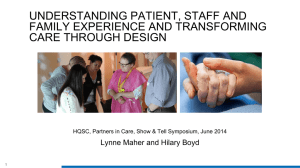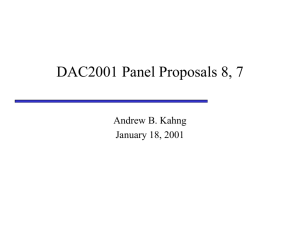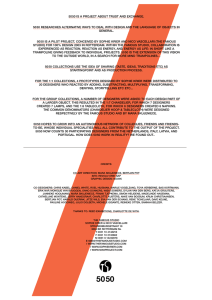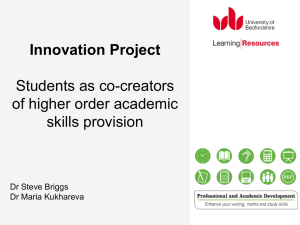Document 13141485
advertisement
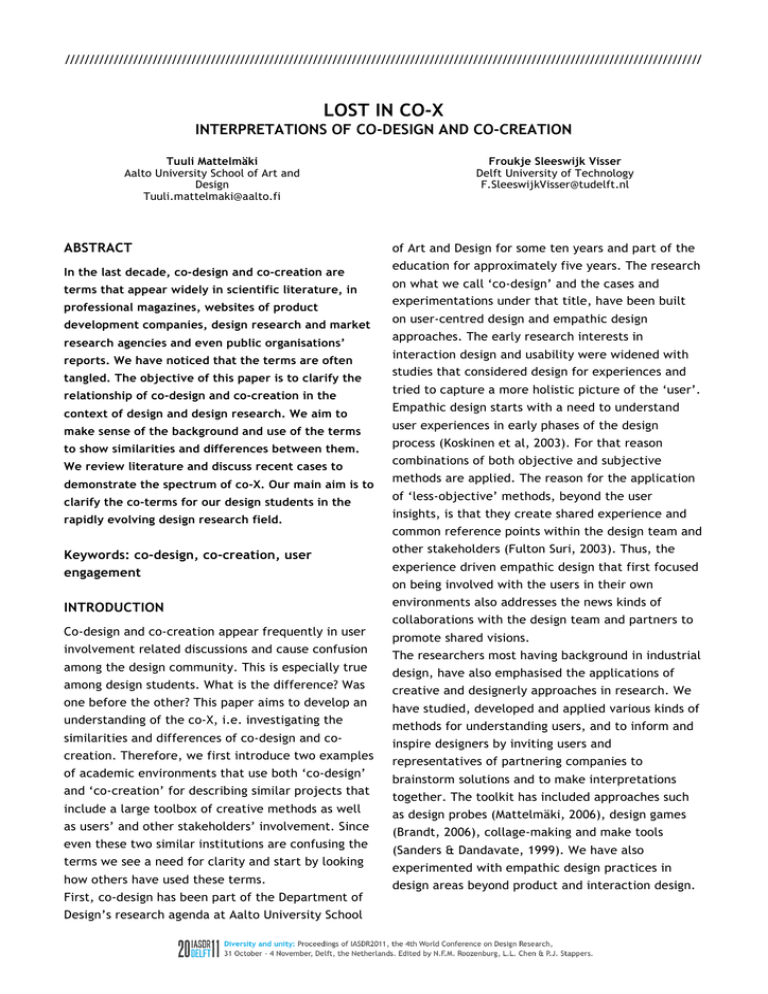
/////////////////////////////////////////////////////////////////////////////////////////////////////////////////////////////////// LOST IN CO-X INTERPRETATIONS OF CO-DESIGN AND CO-CREATION Tuuli Mattelmäki Aalto University School of Art and Design Tuuli.mattelmaki@aalto.fi ABSTRACT In the last decade, co-design and co-creation are terms that appear widely in scientific literature, in professional magazines, websites of product development companies, design research and market research agencies and even public organisations’ reports. We have noticed that the terms are often tangled. The objective of this paper is to clarify the relationship of co-design and co-creation in the context of design and design research. We aim to make sense of the background and use of the terms to show similarities and differences between them. We review literature and discuss recent cases to demonstrate the spectrum of co-X. Our main aim is to clarify the co-terms for our design students in the rapidly evolving design research field. Froukje Sleeswijk Visser Delft University of Technology F.SleeswijkVisser@tudelft.nl of Art and Design for some ten years and part of the education for approximately five years. The research on what we call ‘co-design’ and the cases and experimentations under that title, have been built on user-centred design and empathic design approaches. The early research interests in interaction design and usability were widened with studies that considered design for experiences and tried to capture a more holistic picture of the ‘user’. Empathic design starts with a need to understand user experiences in early phases of the design process (Koskinen et al, 2003). For that reason combinations of both objective and subjective methods are applied. The reason for the application of ‘less-objective’ methods, beyond the user insights, is that they create shared experience and common reference points within the design team and Keywords: co-design, co-creation, user engagement other stakeholders (Fulton Suri, 2003). Thus, the INTRODUCTION environments also addresses the news kinds of Co-design and co-creation appear frequently in user involvement related discussions and cause confusion among the design community. This is especially true among design students. What is the difference? Was one before the other? This paper aims to develop an understanding of the co-X, i.e. investigating the similarities and differences of co-design and cocreation. Therefore, we first introduce two examples of academic environments that use both ‘co-design’ and ‘co-creation’ for describing similar projects that include a large toolbox of creative methods as well as users’ and other stakeholders’ involvement. Since even these two similar institutions are confusing the terms we see a need for clarity and start by looking how others have used these terms. First, co-design has been part of the Department of Design’s research agenda at Aalto University School experience driven empathic design that first focused on being involved with the users in their own collaborations with the design team and partners to promote shared visions. The researchers most having background in industrial design, have also emphasised the applications of creative and designerly approaches in research. We have studied, developed and applied various kinds of methods for understanding users, and to inform and inspire designers by inviting users and representatives of partnering companies to brainstorm solutions and to make interpretations together. The toolkit has included approaches such as design probes (Mattelmäki, 2006), design games (Brandt, 2006), collage-making and make tools (Sanders & Dandavate, 1999). We have also experimented with empathic design practices in design areas beyond product and interaction design. DIVERSITY AND UNITY Without exception the experiments in which users or the term co-creation to either indicate that in a other stakeholders are invited to contribute to the project users are actually ‘creating’ new ideas design process have been called co-design under the themselves (through the guidance of design larger mindset of user-centred design (UCD). In co- researchers) or to indicate an iterative process of design the designers (or design researchers) typically user involvement and users and stakeholders are facilitate the collaborative process but often also consulted in every stage of a design process such as participate in the process as one of the contributors. product development (see e.g. Sleeswijk Visser and The co-design activities typically aim at searching Visser, 2005). Both of the descriptions of co-creation new potential directions and producing design ideas are what the Aalto design researchers refer to as co- and solutions. However, they can also be about design as an umbrella term. making sense of the topic or expressing experiences Co-X competence in both of these academic collaboratively. But even then the activities are part environments has grown in close connection with the of design related processes one way or another, development of industrial and interaction design but typically in the early phases of the exploring. the application area is getting wider since a few Second, at the faculty of Industrial Design years. The kind of co-X activities that we tend to Engineering, Delft University of Technology, a similar apply can also support various kinds of collaborations development has been taken place. We have been outside the more traditional design field. These new exploring the co-X methods and techniques in our fields include social design (e.g. Brown, 2009), research agenda and education for the last ten years transformation design (Burns et al, 2006), service as well. ID-StudioLab, a design research community design (e.g. Evenson, 2005) and activities related to within the faculty, promotes and conducts user- design thinking (e.g. Brown, 2009). centred design projects (van der Helm et al, 2010). WIDENING THE VIEW OF CO-X New methods and tools are continuously being developed to fruitfully involve users in the design In the following section we go through some of the process (see e.g., van Rijn et al, 2009, Stappers et relevant approaches and authors for discovering the al, 2009 and Saakes, 2007). Contextmapping various aspects of co-X. We are aware that there are (Sleeswijk Visser et al, 2005), for example, as a much more, but we have chosen ones that have been procedure, was developed to research people’s either influential to our co-X dilemma in the first everyday context in order to inform and inspire the place or are timely examples of the current design process. Contextmapping is based on the confusion in the application of co-X. application of self-documenting kits and make tools (Sanders, 2001) and involves users as experts of their PARTICIPATORY DESIGN AND CO-DESIGN experiences in the design process. We have not Participatory design (PD) is tightly connected to co- particularly been using the term co-design for our X. PD has its roots in the 70s Scandinavia, where projects, but like design researchers at Aalto joint decision-making and work practices started to University, we have applied various kinds of methods receive attention. One of the key words in PD is for understanding users, invited users and empowering; the ones who are affected by design representatives of partnering companies to explore, should have a possibility to influence the design. The brainstorm and interpret together. participants are also seen as beneficial contributors In contrast, we have been using the term co-creation to the design by offering their expertise and when users are stepping into the shoes of designers, knowledge as a resource in the process. The early PD are given tools to be able to ‘create new ideas’ and projects were mostly conducted in work-settings. PD are facilitated in the creation process by designers approaches had connections with political and researchers. However, stepping into the shoes of statements on e.g. the workers’ possibility and right designers might indicate different roles for these to affect their work (among others Ehn, 2008). users as in co-design activities. A user can be an PD thus is about involving users in design or as Ehn information provider, a creative mind, an evaluator writes “with a special focus on people participating of new ideas, etc. To be honest we ambiguously use in the design process as co-designers” (Ehn, 2008, p. 2 PRODEEDINGS IASDR2011 93). They are envisioning use before it actually takes Dutch and Nordic research communities which is why place. This also underlines one of the characteristics his view on co-designing can be a valuable example. of co-design: it is about users or more generally, He states ”As I firmly believed in the UCD I decided people imagining and planning with issues that are to fully involve users in the creative process of not-yet-existing and utilizing the skills that are in the finding solutions to support their work by conducting core of professional design competence. co-design sessions.” (p.105). He then continues Participatory design and co-design are often used as describing the co-design workshops that he calls synonyms in the Nordic countries. Co-design carries dialogue labs referring mostly to authors within the perhaps a bit lighter weight on the political attitude PD tradition such as Buur, Binder and Brandt. He thus but builds on the same mindset and tools. builds on user-centred design (UCD) in which PD In a recent book published by DAIM project (Halse et inspired co-design is part of the process. al, 2010) Binder (2010), a representative design Adding an Italian perspective to our exploration we researcher with Scandinavian PD background, looked how Rizzo (2010) describes co-design as an describes co-design sessions as workshops “for umbrella that connects a range of tools and sketching and trying out possibilities” (p. 19). His practices. She does not refer to co-design as a colleagues Brandt and Agger Eriksen (2010) further synonym to PD but sees it as an evolutionary describe co-design events as ‘series of meetings into approach from UCD. However, she underlines that which the core design team invites other important UCD and co-design are different. UCD is a precise stakeholders’. The name co-design event according design methodology whose ‘application conducts to them points out "the open-ended, collaborative, designers to develop usable design solutions for end exploratory and creative” working mode, i.e. “They users’ while co-design ‘is a set of creative techniques are temporary spaces for experimentation and whose aim is to inspire the design process.’ In her collaborative learning.” (p. 71). Although the weight view, the shifts from UCD and object-centred view to in the book is in the term co-design, the team also pleasure and experience-driven perspectives have recognises the presence of co-creation: the material set the ground for co-design. Both university units for co-design events needs to be designed so that it described earlier have witnessed this evolution and invites and facilitates co-creation (Foverskov and relate to Rizzo’s view, however, also influences from Dam, 2010, p. 44). Here co-creation is an activity or PD can be identified such as the empowerment a moment of creating something together, thus takes attitude. place in the co-design sessions that are about Keinonen (2009) has reflected on design research collaborative exploration, planning and learning. In methods and has identified that there are three this project manifesting ‘users’ or their involvement layers in them: instrument, competence and agenda. is not really the issue. Instead various people from In his view method is not just an instrument that can shopping mall customers to shop managers and waste be taken from the shelf, but the application can be handling experts are invited to ‘rehearse the future’ built upon a particular personal competence such as with the support of the co-design methods. empathic sensitivity. Furthermore, certain methods In another recent publication (van der Lugt et al, and their applications can be part of an agenda such 2009) from the Dutch context titled Co-design as advocating for the empowerment of employees in Pressure Cooker co-design is defined as a method in the decision-making. which users are invited to actively participate in the The discussion above can be summarised with design process similar to PD. Here the term ‘co- Keinonen’s layers. Co-design connected with PD has design’ is explicitly used as a collection term for the an agenda. It is about empowering people that are many methods that can be applied in different stages affected by the design. It also emphasises an of the design process. Whereas ‘co-creation’ experience-driven mindset. In addition co-design is a according to the authors is one of the methods of co- set of tools, instruments that allow and trigger co- design, in which users create solutions. design and events as forums in which the co-design Also Lucero Vera talks about co-designing in his takes place and in which the tools are applied. The doctoral thesis (2009). He has been exposed to both competence in co-design seems to have a role too: 3 DIVERSITY AND UNITY the future ‘users’ are invited to utilise their make tools, are ”a new language for co-design” (p. competence, experiences and creativity for design. 90). Co-design is about as facilitation of “exchange However, although the presence of ‘users’ is between people who experience products, acknowledged as the starting point, the participants interfaces, systems and spaces and people who in co-design can be selected with a wider scope. design for experiencing.” This is one of the key Finally, co-creation seems to open up into two publications that has influenced both co-design and interpretations: the first one is a creative moment, experience design and connects strongly to Rizzo’s atmosphere in a co-design event. The second is a view on co-design. method in the co-design process or during an event In 2001 Sanders stresses the need of a new attitude where the users create solutions. in design for experiencing. It is about respecting the opinions and creativity of people designers are GENERATIVE APPROACH AND CO-X designing for. She introduces a concept collective One of the influential practitioners in emphasizing creativity and believes that it is more potential and users participation in design is Liz Sanders whose powerful than individual creativity. (Sanders, 2000) work has greatly inspired and affected both of the Her 2001 article (Sanders and William, 2001) authors’ work and teaching. We have adopted her continues the discussion based on creativity approaches for enhancing everyday people’s creative references. She elaborates on the need of supportive expression and the mindset of valuing people being tools for harnessing people’s creativity with visual experts of their own experiences. In order to clarify communication. In another publication from 2002 she her stand we conducted a review on Sander’s continues with the same line of thought, now publications which is summarized in the following: introducing a new design space namely co-design Sanders (1992) sees that participatory design is user space in which ”interdisciplinary experts in design centred design taken to another level. Her thoughts and research will work together with ordinary have similarities to Scandinavian PD community’s but people.” (Sanders, 2002) she does not refer to its work. Here, the In her paper from 2005 (Sanders, 2005) she further participation is about involving consumers in the develops the earlier concept of collective creativity design process. She contrasts this approach to and brings forward the term co-creation. It is about traditional UCD where user research is about everyday people’s (who were called earlier as questionnaires, lab tests and focus groups, and in consumers and then as end-users) creativity and which these results are reported to the designers. eagerness in being involved and expressing their She further points out that participation does not creativity. Sanders calls for ‘co-creating spaces’. consider only users but also all the stakeholders in Those are settings in which designers and everyday the product development process (which stems with people work collaboratively throughout the design DAIM’s co-design mindset.) development process. Her ‘co-creating spaces’ can In her keynote from 1999 she emphasizes the end- be interpreted close to what DAIM researchers call users’ role. In her opinion they can and should be the co-design events, however in her view they are not most important players in the design process. She temporary but something that take place during the defines co-design as “people designing together” whole design process. This happens when people collectively apply new In the more recent publication (Sanders and kinds of visual tools as they participate in the design Stappers, 2008) she refers to co-creation as ‘any act process. (Sanders, 1999). of collective creativity, i.e., creativity that is shared The publication from 1999 (Sanders & Dandavate, by two or more people’. Whereas co-design is used 1999) contextualizes her work with what she calls ‘to indicate collective creativity as it is applied the emerging participatory design approach. Her across the whole span of a design process’. This main point in the paper is that ”it is possible to gain shows that she sees co-creation as a very broad access to the experiencer’s world only through his or concept and when applied in design “co-design is her participation in expressing that experience.” The specific instance of co-creation”. This statement is tools for participation and expression that she calls 4 PRODEEDINGS IASDR2011 in contrast with the earlier interpretation that cocreation happens in co-design events. This review of Sanders’ publications resulted an understanding of how her application of the co-x terms has been elaborating over the years including a strong agenda and development of instruments. Firstly, she stresses involving users who she calls ‘everyday people’ in the product development process. Secondly, she also introduces new kinds of tools that aim at supporting people in expressing their experiences and using their creativity in the design process. Figure 1. The four co-design directions: A) The users are given voice and their expertise is utilised in the design process; B) Users contribution is facilitated with tools provided by the designers or researchers; C) The designer is not only a facilitator but participates in the collective creation; D) Designers and design researchers support and facilitate a collaborative process of various stakeholders, not just users. Thirdly, she points out the attitude building of respecting everyday people’s creativity and Fourthly, enhancing the creativity and exchange between people in a process she calls space for collective creativity (co-creation). In her view the actual creation in co-creation is the collective EVEN MORE CO-XS creativity, and therefore design (in the co-design) is Co-creation as a term also appears outside the just a part of the bigger collective creativity. What design field such as in business literature and she seems to refer to as co-creation, rather than a marketing and has been brought up e.g. by Prahalad process or practice in design, is a larger trend of and Ramaswamy (2000) about ten years ago. They openness and creative mindset. talk about creating value with customers as part of Summarising the discussion above co-design seems to market and business strategy. The business-like open up into four directions. The first one perspective on the term co-creation has gained much emphasises the role of the user following the attention and involves new topics such as mass- traditions of UCD and participatory design. Its main customization and open innovation. concern is that the users voice needs to be heard in A form of co-creation in business also appears in the the design process. The second direction focuses on sense of being creative together, which seems to methods and tools that support users to tell about stem with Sanders’ thoughts on collective creativity. their experiences and design ideas that can be For example John Winsor (2006) in his book titled interpreted and that inspire design. The third is “Spark- Be more innovative through co-creation” about design collaboration in which users and states that co-creation is about engaging with the designers and alike exchange ideas, envision in a internal team as well as with the customers and collaborative creation process. In the fourth their. His examples of co-creative practices are e.g. direction users have important roles but other using visual triggers, cross-pollination of ideas and stakeholders are also meaningful in the exploration providing inspiring spaces for sharing and discussing and envisioning process. This direction does not put in the offices. Windsor also points out the emphasis on the engagement of the users but invites importance of creating new kinds of dialogues with a wide range of people to brainstorm and learn the customers. In this way co-creation is not together. The engagement often takes place in necessarily connected to design as such but indicates several workshop-like events. In these events an atmosphere and practice of fruitful and creative envisioning and making are important and innovative business. co-creation needs support with methods and Another example of the wide applications of co-X materials. points at open innovation. A strategic consultancy, Fronteer Strategy, in The Netherlands defines cocreation as “the practice of collaborative product 5 DIVERSITY AND UNITY and service development: developers and health services could be a process in which the stakeholders working together” (Paaper, 2009, p. 2). patients, citizens or collaborative communities take They see co-creation as a large concept related to responsibilities in creating and contributing to open innovation where ownership and openness of services along with e.g. health care professionals in the process are the main concerns. They thus use the the public sector. Then, the term co-creation is used term co-creation as a mindset and collection of tools to describe a longer process of dialogues and rather than a focused method. engagement that includes sharing risks and Without going further to the open innovation or the responsibilities in particular, not a unique event or questions concerning ownerships in e.g. mass- moment in a workshop. In this anticipated situation innovation these timely examples illustrate the everyone is a designer according to Cottam and current trend of engaging various kinds of people in Leadbeater’s view. The professional designer’s role collaborative or collective contributions. In then becomes one of a coordinator, developer and conclusion, business and marketing are using the co- provider of co-creation tools (Cottam and creation term widely to address any stakeholder Leadbeater, 2004). This view is in line with Sanders’ involvement and/or engagement in innovation thoughts. processes. This review shows the unclear use of co-design and Moreover, the new boom of ‘service design’ further co-creation terms and that co-X covers a wide range confuses the usage of the co-X concepts, co-creation of activities both within the design field and beyond. in particular. Service design is often referred to be In design context co-creation addresses creative human-centred and the many of the tools utilised collaboration within organizations, between the come from UCD and PD practices from observation design teams and users, but also among other and probes to various kinds of co-X workshops (see experts, collaborative companies, or even networks e.g. Miettinen and Koivisto, 2009). However, co- of stakeholders. The objectives of such activities are creation in service design is applied to mean at least to apply the various participants’ expertise into two things according to Birgit Mager (2009). First, design projects as well as to support engagement in clients and customers participate in to the process of change-oriented goals whether defined as ‘design’ or exploration and creation alike PD and in Sanders’ referring to other kind of development processes. approaches. Second, the customers also participate To summarise the review we list our findings: to the service delivery process, i.e. services are not Co-design is purchased as goods but they are produced and • utilised in design context in which designers are consumed in interaction with the customer and involved and the topic of the activity is related to service provider. design exploration, envisioning and solution Also Vargo and Lusch (2008), who advocate for development. service dominant logic instead of traditional • an empowering mindset and it gives voice and marketing thinking, point out the service co-creation tools to those who were not traditionally part of as “assisting customers in their own value-creation design process. process” (p. 257). One of the mindsets behind the service-dominant logic is customer-centric thinking, • about engagement of potential users but also but it also points out bringing organisation partners about stakeholder collaboration. to join the co-creation process. • a process and tools of collaborative engagement, This is where a lot of the confusion comes from: e.g. events for learning and exploration. methods that were developed for co-designing with Co-creation in design potential users or other stakeholders are now utilised • is a creative, mood/mindset and methods within in service design to create potential service solutions co-design process with clients, the solutions of which are then to be co-created with customers and producers. • is about exchange of ideas, experiences, Taking the participation even beyond PD, Cottam expertise and Leadbeater (2004) suggest that co-creating 6 PRODEEDINGS IASDR2011 • is temporary. It has specific parts within the a service journey project in which the designer’s role design process was in the planning of the stage for the collaboration Here we have mostly focused on the terms being in early phase of a service design project. The last used in the design field. It has to be emphasised that case describes a service development project with co-creation, however, has several meanings beyond the mindset of users having a large role in the design: delivery of the service and were therefore involved in many stages during the entire process, but as not • a collective creativity as a mindset for as designers, but as themselves in their everyday collaborative activities (Sanders) lives. • business discussion about openness and exchange as well as networking and crowdsourcing to CASE 1 TEXTILE DESIGNER BUILDS A CREATIVE create new values INTERACTION WITH CO-DESIGNERS • service co-creation as the moment of creation The first case illustrates kids as co-designers. A when a service is being delivered and even textile designer wanted to involve school children sharing responsibilities when creating and offering into a process of creating textile prints for children. services The objective was to gain an understanding of the Based on the literature above and our own kids’ world, their preferences and to listen to their experiences we have identified that the following opinions in a creative process. The kids were first issues seem to have influenced the usages of the co- explained what textile design is about. Secondly, X terms: they were given a set of hand made probing tasks a) The tradition, discipline, community and the that included questions for telling about their lives, discussion the co-X practice or research contributes hobbies and such, colour samples for selecting the to (PD, creativity, services, marketing, open favourite colours, drawing tasks for telling about innovation) their homes, their dream rooms and creating textile b) The attitude from user empowering to stakeholder patterns. The designer then analysed the probing engagement (whose contribution is allowed and materials, made interpretations of the colours, the emphasised) lifestyles and pattern preferences and collected b) The professional backgrounds and the roles when them into mood boards and inspired by the results using the methods (designers or researchers and the designed a set of patterns. Finally, the designs were level of participation) evaluated by the same children. (Mitrunen 2010) c) The objectives and outcomes (collaborative learning or business profit) CO-X CASES The next section discusses five illustrative cases from our own practice or from our colleagues. These cases are chosen because show the variety and complexity of co-design. The first case shows a project, where an individual designer organises an interactive co-design process Figure 2. The upper row, co-designers instruments and co-design in action. The lower row, resulting design ideas on the left by the children and on the right by the designer. with children. The second case is from business context and shows a typical product design agency that is implementing short user involvement sessions Reflection during their exploratory design activities. The third The process of involving children was described as case zooms in on getting together various co-design because the collaborative engagement was stakeholders and support envisioning and shared part of a design process. The designer (as part of her learning in the development phase of a new building Master of Art thesis) had an agenda of widening her and platform of activities. The fourth case discusses 7 DIVERSITY AND UNITY own creative process with an interaction with the their ideal products. The designers recruit users and potential future ‘users’. There were several steps in ask them to do explorative assignments at home and the dialogue between the designer and the children. come to the studio for a studio meeting. After the The designer engaged the kids by providing them studio meeting, the users’ involvement phase is over. intruments, i.e. triggering tools to reflect their The designers do not call this user involvement co- preferences and express their visual creativity. They creation or co-design. But they refer to these also evaluated the resulting design patterns. activities as contextmapping. This case illustrates However, the designer kept her designer identity and that even core design activities of design agencies competence and was the one who was responsible of are starting to see the benefit of involving users the final designs – although strongly inspired by the during idea generation. This is in line with Sanders’ exchange with the kids, which could be described as way of emphasising creativity and expression of co-creation in Sander’s words. experiences. However, in the spectrum of co-x this is a very small user involvement, and all authorities and responsibilities are in the hands of the designers. CASE 2 FINDING WAYS TO INVOLVE USERS IN SHORT IDEA GENERATION SESSIONS The second case is about a small design agency based CASE 3 ENVISIONING THE COLLABORATION in the Netherlands (WAACS) that started to ENVIRONMENT consistently involve users in the idea generation The University of Art and Design Helsinki, Helsinki phase since two years. The second author is often University of Technology and Helsinki School of shortly involved as a consultant of user involvement. Economics were merged to become Aalto University Sporadically they have asked or observed users to in the beginning of 2010. The objective of the merge understand the context of use, but were not is to build an innovative environment for multi- accustomed to involve users systematically before. disciplinary education and research. One of the designers, trained in contextmapping One of Aalto University’s key projects is Design introduced this method in a project to the other Factory (DF), a building and a platform that aims at designers, which led to inspired insights for new joining people and activities from different product solutions. Since then, they have invested departments. DF’s main focus is in product time and money to conduct user research in more development education and research but it also and more projects. includes places for teamwork, meetings and various forms of collaboration with companies as well as Reflection workshops for experimenting and prototyping. The design agency’s core business is designing As the planning of the DF was still in progress design products. They see the value of involving users as a researchers proposed to organise three creative quick reality-check, i.e. to learn from users what workshops, to discuss, envision and prototype DF they didn’t know themselves or get confirmation together with the potential users. The workshops about what the designers think the users’ needs are. served also as a collaborative stage for discussion The role of the users is being informants to spark among different stakeholders such as professors, inspiration and to provide information about their students and researchers from three partnering everyday lives around a specific topic such as e.g., schools. glue rollers. Where, how, what, when, why do they The first workshop focused on setting a common glue things and how do they experience that? The vision of the core spirits and values of DF, the second users are regarded as experts of their experiences workshop focused on people and practices, i.e. and through the user study the context of product collaboratively identifying the key actors, the use is brought into the design studio. activities and work cultures. The third workshop The designers are the creators having responsibility focused on brainstorming spatial solutions. It aimed of the quality and quantity of the created ideas. The at planning, concretizing and prioritizing the users are not creating design solutions although they activities identified in the previous workshop in the might suggest some ideas as they are asked to draw actual setting of the DF. 8 PRODEEDINGS IASDR2011 The workshops were inspired the design games well as in the resulting report that has functioned as approach (Brandt 2006) that has its roots in the the reminder for further development. participatory design tradition. They combined elements from board games such as game rules, CASE 4 STAGEING DESIGN COLLABORATION turn-taking, game board, and playing cards. They The fourth case is about facilitating a process in also applied elements of make tools (Sanders and which the aim was to streamline customer services. Dandavate 1999). Each workshop was an event for Three co-design workshops were organized with the reflection and the outcomes were transferred, e.g. aim of gathering people from a complex network of through the customized game materials, to the next stakeholders together to discuss, plan and envision event. future service systems. The participants included people from a public organisation and its partners. The case is an example of a trend in which public organisations and individual service providers are learning customer-oriented service business. The transformation process requires facilitation in the learning of new attitudes and helping out of the box thinking in organizations. (Hakio & Mattelmäki 2011) Figure 3. Outcomes of collaborative ideation in DF Reflection The DF workshops were facilitated and planned by design researchers who were also anticipated users of the setting. They called the workshops co-design workshops because of the application of design games methods and because the process aimed at design solutions in addition to collaborative envisioning. The facilitators also joined the teams Figure 4. Design games as the platform for collaborative reflection along with the other participants as equal codesigners. The outcomes of the workshops, such as the spirit statements, the map of the actors and The workshops applied design games as a way to activities as well as the envisioned solution proposals stage the collaboration. With the help of materials were documented and reported to all the that were specially designed for the purpose such as participants, heads of DF and the people responsible game boards, game rules, human-figures the aim was of the interior design (who also took part of the to support collaboration, discussion, reflection and workshops). The process enabled people to share communication of how the elements of service their ideas, express their needs and become familiar experience are connected. Teams were mapping the with each other and DF. The applied methods and existing practices, purposefully stressing the materials aimed at supporting exploration and customer- or human-centered perspective and creative collaboration. How much the process creatively seeking improvements. The organization actually influenced the final designs and the action had the responsibility of the implementation of the plan of the DF has not been properly investigated. ideas. However, feedback from the workshop participants and the key persons is DF development, (as well end- Reflection users of DF) indicates that the value of the workshop The co-design workshops were planned and was in the engaging process in which a number of facilitated by design researchers. The reason for players joined to discuss, learn, envision and plan calling them co-design is due to the design games together in a well structured but creative manner as method and the mindset of considering things that 9 DIVERSITY AND UNITY do not exist yet. However, the outcomes were not plan for the social enterprise and how to set up the really designs but rather a common understanding of organisation. the complexity and visions and ideas for the improvement. The workshops were planned to trigger creative atmosphere, facilitate discussions within and among teams, as well as the development of the overall picture of service processes and how they interact with the customer’s world. The process resembles co-design as described by Daim project, i.e. staging temporary learning and experimentation events. The co-creation happens in the interaction among the participants. In this case designer’s role was purely in the consulting, i.e. Figure 5. One of the participants is reacting on the propositions for a new service presented in a brochure planning of the process, introducing and adjusting the tools and supporting of the mindset building. The Reflection continuity in implementing the initiatives was in the In this case users were involved in several stages of organization, the teams and individual participants. the service. They were visited, observed, interviewed about their everyday lives and some of CASE 5 INVOLVING USERS IN THE DESIGN AND them also gave feedback about the service ideas DELIVERY OF SERVICES created by the design team. Furthermore, users also The project Gettogether was conducted in 2009 by participated for two months in the experiential Participle (www.participle.net), a design company prototype usages of the service. The interesting for public services, and the client was a aspect here is that the users had an important role in governmental organisation in the UK. The aim of the the content production of the planned service and project was to develop a service with a social thus their role was considered important in the component to enhance the lives of elderly people development process. However, they had not been who are in social isolation and feel lonely. The asked to step into the designer’s shoes, use designed service was a telephone group for having designerly tools, be creative or generate ideas in a phone chats with other people who are also often design setting. Everything took place in their homes isolated in their homes. and their roles were to be themselves: everyday The project team approached the topic in various people. ways including interviews and spending time with The design process involved users and other several older people, caregivers and community stakeholders iteratively in many phases of the workers. Equipped with the gathered understanding development process. The design responsibility the project team developed several ideas which remained in the design team however. The project were then presented to the same elderly people for team never explicitly used the term co-design during feedback. the project and in the documentation of this project. As the concept was developed on the idea that users Is this co-design then? In our opinion it is. The would also be part of the service production an developed service is also about co-creation in the experiential prototype as built. Through the pilot sense presented: the user participates in the service usage of the prototype the team was also able to experience. observe how the elderly would use this service; what roles they took and how the filled in part of the DISCUSSION service with their own needs and capabilities. The end result of the project was a report with the This diversity of the cases above gives insight in the design of the service, a blue print and a business various aspects of co-design such as roles of designers, design researchers, users, and other 10 PRODEEDINGS IASDR2011 stakeholders. Designers facilitate and enhance the In this paper we wanted to clarify the ambiguous creativity of others, learn with and are inspired from uses of co-design and co-creation. This has been other co-designers. These cases also illustrate how motivated by a desire to teach our students what the co-design can vary depending on the organization co-X tools are, but what to do with them and how and the field of design. Co-design takes place in they are constructed. For that they need to know product design setting as well as in educational that co-design processes asks for an open mindset of environment. There is also a great variety on how all involved people. Moreover, it is a fruitful but they are organized including the time span of the complex process that takes time and effort. Finally, engagement and the phases of the development the complexity (defining different roles, stepping in process. There are differences in the level of the stepping out, and creating/providing the right tools contributions from end users and stakeholders. at the right moment to the right people) of Moreover, all of the cases are built on a particular organising such processes asks for skills and decisions mindset that in the application of the tools. This is particularly 1) emphasises that people, whether users or other useful when co-design approaches and design actors, can be contribute to design when they are competences are needed in new application areas valued and they given the possibility. This has to do such as service design, transformation design or both on the empowering attitude but also in the idea social innovations. of their valuable contribution through their own experience and expertise; 2) believes that the collective activity creates an REFERENCES exchange of ideas, collective exploration and Binder, T. (2010) Beyond methods. In Halse, J., Brandt, E., Clark, B., Binder, T. (eds) Rehearsing the future. The Danish Design School Press, Denmark. learning that is more than individual reflection and; 3) concerns with envisioning and ”what if” questions, Brandt, E. & Agger Eriksen, M. (2010) Co-design events. In Halse, J., Brandt, E., Clark, B., Binder, T. (eds) Rehearsing the future. The Danish Design School Press. Denmark. i.e. it is not about understanding specific phenomena but aims at exploring and finding design ideas, reasons, problems and opportunities with the goal of change. Brandt, E. (2006) Designing Exploratory Design Games: A Framework for Participation in Participatory Design? In Proceedings of PDC 2006, Trento, Italy. Vol. 1, 57–66. CONCLUSIONS Brown, T. (2009) Change by Design. How design thinking transforms organisations and inspires innovation. HarperCollins, New York. In the beginning of the paper we were lost in the Burns, C., Cottam, H., Vanstone, C., Winhall, J. (2006) RED paper 02: Transformation Design, Design Council. www.designcouncil.info/mt/RED/transformationdesign/ terms of co-creation and co-design. Through literature review and case descriptions we have Cottam, H.& Leadbeater, C. (2004) RED Paper 01: HEALTH: Cocreating Services. Design Council. UK.www.designcouncil.info/RED/health/REDPaper01.pdf made landmarks into the map of co-X. We did not aim to one definition of the relationship of the terms but rather to clarify their use. Ehn, P. (2008) Participation in Design Things. In Proceedings of Participatory Design Conference, Indiana University. US. 92-101. Every design process aims at exploring and finding Evenson, S. (2005) Designing for services. Designing Pleasurable Products and Interfaces DPPI. Eindhoven, The Netherlands. 149161.. design solutions. Co-design is a process and the planning, adjusting tools and facilitation is built on a mindset based on collaboration. Co-creation can take Foverskov, M. , Dam, K. (2010) The evocative sketch. In: Halse, J., et al (eds) Rehearsing the future. The Danish Design School Press. place within co-design processes but focuses much Fulton Suri, J. (2003) The experience of evolution: developments in design practice. The Design Journal, vol6 no2. Ashgate publishing U.K.39-48 more on the collective creativity of involved users and stakeholders. When looking from another perspective outside Hakio, K & MAttelmäki, T. (2011) Design adventures in public sector. DPPI2011. In press. design research and practice co-creation appears as Halse, J., Brandt, E., Clark, B., Binder, T. (2010) Rehearsing the Future. The Danish Design School Press. a bigger trend that deals with openness, collaboration and partnership. From that perspective van der Helm, A., Stappers, P.J., Keyson, D., & Hekkert, P. (2010) The ID-StudioLab 2005-2010: Further developing a creative research environment. In: Achten, H., de Vries, B., & Stappers, co-design is among the practices in which cocreation is concretized. 11 DIVERSITY AND UNITY P.J. Design Research in the Netherlands. Proceedings of the Symposium May 20-21 Eindhoven. Sanders, E.B.-N. (1999) Postdesign and participatory culture. In Keynote proceedings of the Useful and critical conference. University of Art and Design Helsinki. Keinonen, T. (2009) Design Method –Instrument, Competence of Agenda? Multiple ways to Design Research, Swiss Design Research Network Symposium '09. 12–13. Sanders, E. B.-N. (2000) Generative tools for codesigning. In Scrivener, Ball and Woodcock (Eds.) Collaborative Design. Springer Verlag. London. Koskinen, I., Battarbee, K. & Mattelmäki, T. (eds) (2003) Empathic Design. IT press. Finland. Sanders, E. B.-N. (2001) Collective Creativity. LOOP: AIGA Journal of Interaction Design Education, August, Number 3. Lucero Vera, A. (2009) Co-Designing interactive spaces for and with designers: supporting mood-board making. Doctoral dissertation. TU Eindhoven. Jyväskylä Finland. Sanders, E.B.-N. (2002) Scaffolds for experiencing in the new design space. Information Design Institute for Information Design. Japan (Eds), IID.J, Graphic-Sha Publishing Co.Ltd. Van der Lugt et al. (2009) Co-creation pressure cooker. Sanders, E.B.-N. (2005) Information, Inspiration and Cocreation. Proceedings of the 6th International Conference of the European Academy of Design. Bremen Germany. Mager, B. (2009) Service design as an emerging field. In: Miettinen, S. & Koivisto. M. (eds) Designing Services with innovative methods. Publication series of the University of Art and Design Helsinki. Keuruu Finland. 28-43 Sanders, E.B.-N. and Dandavate, U. (1999) Design for experiencing: New tools. Proceedings of the First International Conference on Design and Emotion, Delft, The Netherlands. 87-92. Mattelmaki, T. (2006) Design Probes. Doctoral Thesis. University of Art and Design Helsinki, Finland. Sanders, E.B.-N., Stappers, P.J. (2008) Co-creation and the new landscapes of design. Special issue of CoDesign, 4 (1), 5–18. Mattelmäki, T., Hasu, M., Ylirisku, S. (2009) Creating Mock-ups of Strategic Partnerships. Proceedings of IASRD conference in Seoul, Korea. Sanders, E.B.-N., William, C.T (2001) Harnessing People’s Creativity: Ideation and expression through visual communication. In: Langford, J., McDonagh-Philp, D. (eds.) Focus Groups: Supportive effective product development. London: Taylor and Francis. Miettinen, S. & Koivisto. M. (eds) Designing Services with innovative methods. Publication series of the University of Art and Design Helsinki. Keuruu Finland. Mitrunen, E. (2010) Kuosit käyttäjiä kohtaamassa (Patterns meet users). Unpublished Master of Art thesis. Aalto University School of Art and Design. Helsinki Finland. Sleeswijk Visser, F., Visser, V. (2005) Re-using users: Co-create and co-evaluate. Personal and ubiquitous computing, 10(2–3).148– 152. Prahalad, C.K., Ramaswamy, V. (2000) Co-opting customer competence Harvard Business Review 78(1). Sleeswijk Visser, F., Stappers, P.J., van der Lugt, R., Sanders, E.B.-N. (2005) Contextmapping: Experiences from practice. CoDesign: International Journal of CoCreation in Design and Arts, 1(2). 119–149. Paaper, M. (2009) Co-creation’s 5 guiding principles. Or….what is successful co-creation made of? White paper of Fronteer Strategy. 2009 (www.marketing-online.nl/images/24724.pdf) van Rijn, H., Sleeswijk Visser, F., Stappers, P.J. (2009) Connecting through interacting: Toys that help designers learn from children with autism by playing with them. International Association of Societies of Design Research 2009: Rigor and Relevance in Design, 18-22 October, Seoul, South Korea. Stappers, P.J., van Rijn, H., Kistemaker, S., Hennink, A., Sleeswijk Visser, F. (2009) Designing for other people's strengths and motivations: Three cases using context, visions, and experiential prototypes. Advanced Engineering Informatics, Special Issue on Human-Centered Product Design and Development, 23(2), 174-183. Rizzo, F. (2010) Co-design versus User Centred Design: Framing the differences. In Guerrini, L. (Ed) Notes on Design Doctoral Research. Franco Angeli Editore. Vargo, S. L., Lusch, R. F. (2008) From goods to service(s): Divergences and convergences of logics. Industrial marketing management 37. 254-259. Saakes, D.P. (2007) A media toolbox for ideation workshops. Tools in Support of Creative Collaboration, as part of Creativity and Cognition, Washington D.C, June 13-15. Winsor, J. (2006) SPARK: Be More Innovative Through Co-Creation. Dearborn Trade Publishing. Chicago.US. www.participle.net Sanders, E.B.-N. (1992) Converging perspectives: product development research for the 1990s. Design management journal. Fall. 12



